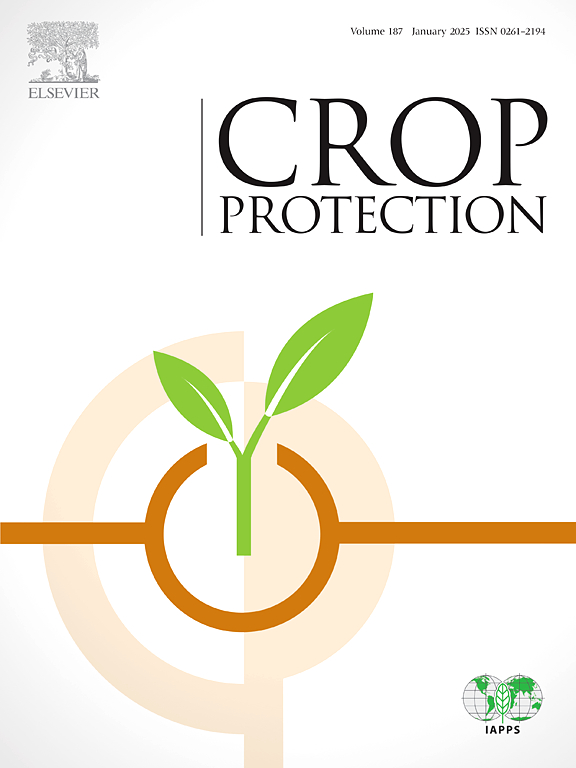人工打顶对害虫发生率和棉花产量的影响
IF 2.5
2区 农林科学
Q1 AGRONOMY
引用次数: 0
摘要
棉铃虫和吸食汁液的害虫是非洲棉花生产的主要制约因素。对棉花植株进行人工打顶,即切掉植株顶部(即主茎的顶芽),可以消除某些害虫的资源或诱导植株防御,是化学防治的一种很有前途的替代方法。在这项研究中,我们评估了打顶对棉铃虫和吸汁液害虫的保护程度,以及打顶对籽棉产量的影响。我们在马里和塞内加尔进行了六项试验,将杀虫剂保护(喷洒过杀虫剂的地块与未喷洒杀虫剂的地块)和打顶(打顶地块与未打顶地块)结合起来。与杀虫剂保护相比(-55%),打顶本身对棉铃虫的保护作用较弱,受损的棉铃和棉铃的比例减少了 11%。打顶对降低吸汁害虫的发生率(-20% 到 -48%)有低到中等的效果,但与杀虫剂的效果相当。虽然在没有杀虫剂保护的情况下,打顶能大大降低收获时受损棉铃的比例(-31%),但与杀虫剂保护(+52%)不同,这对籽棉产量(+4%)没有实质性影响。不过,这项技术可以与基于阈值的干预措施相结合,整合生物农药,以减少棉花作物保护对环境的影响。本文章由计算机程序翻译,如有差异,请以英文原文为准。
Effect of manual topping on insect pest incidence and cotton yield
Bollworms and sap-sucking insect pests are a significant constraint to cotton production in Africa. Manual topping of cotton plants, which consists of cutting off the top of the plant, i.e. the terminal bud of the main stem, is a promising alternative to chemical control by removing resources for certain pests or inducing plant defences. In this study, we evaluated the level of protection by topping against bollworms and sap-sucking insect pests and the effect of topping on seed cotton yield. Six experiments combining insecticide protection (sprayed vs. unsprayed plots) and topping (topped vs. non-topped plots) were conducted in Mali and Senegal. Topping by itself conferred weak protection against bollworms with an 11% reduction in the proportion of damaged shed squares and bolls, compared to insecticide protection (−55%). Topping had a low to moderate effectiveness in reducing the incidence of sap-sucking pests (−20 to −48%), but equivalent to insecticide treatments. Although topping significantly reduced the proportion of damaged bolls (−31%) at harvest in the absence of insecticide protection, this did not substantially affect seed cotton yield (+4%), unlike insecticide protection (+52%). However, this technique could be advantageously combined with threshold-based interventions integrating biopesticides to reduce the environmental impact of crop protection in cotton.
求助全文
通过发布文献求助,成功后即可免费获取论文全文。
去求助
来源期刊

Crop Protection
农林科学-农艺学
CiteScore
6.10
自引率
3.60%
发文量
200
审稿时长
29 days
期刊介绍:
The Editors of Crop Protection especially welcome papers describing an interdisciplinary approach showing how different control strategies can be integrated into practical pest management programs, covering high and low input agricultural systems worldwide. Crop Protection particularly emphasizes the practical aspects of control in the field and for protected crops, and includes work which may lead in the near future to more effective control. The journal does not duplicate the many existing excellent biological science journals, which deal mainly with the more fundamental aspects of plant pathology, applied zoology and weed science. Crop Protection covers all practical aspects of pest, disease and weed control, including the following topics:
-Abiotic damage-
Agronomic control methods-
Assessment of pest and disease damage-
Molecular methods for the detection and assessment of pests and diseases-
Biological control-
Biorational pesticides-
Control of animal pests of world crops-
Control of diseases of crop plants caused by microorganisms-
Control of weeds and integrated management-
Economic considerations-
Effects of plant growth regulators-
Environmental benefits of reduced pesticide use-
Environmental effects of pesticides-
Epidemiology of pests and diseases in relation to control-
GM Crops, and genetic engineering applications-
Importance and control of postharvest crop losses-
Integrated control-
Interrelationships and compatibility among different control strategies-
Invasive species as they relate to implications for crop protection-
Pesticide application methods-
Pest management-
Phytobiomes for pest and disease control-
Resistance management-
Sampling and monitoring schemes for diseases, nematodes, pests and weeds.
 求助内容:
求助内容: 应助结果提醒方式:
应助结果提醒方式:


